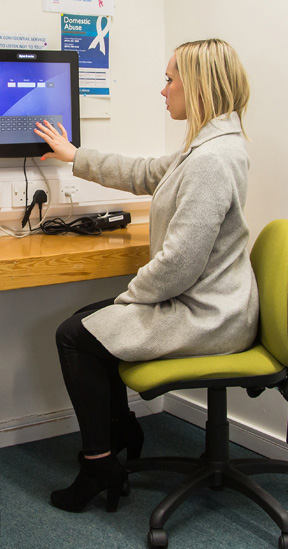How a digital approach to sexual health screening can help clinics sustain service levels amidst funding cuts
With screening services across the country faced with significant budget cuts, while certain sexually transmitted infections are on the rise, clinics are reaching crisis point as they attempt to do more with less. Here, we discuss the progress made in sexual health care to date, the likely impact of reduced funding and why digital technology may be the antidote to the problem.
The sexual health story – where are we now?
Over the years, significant progress has been made in delivering more accessible, effective and efficient sexual health care across the country. We’ve seen the service move from small, isolated cabins behind hospitals to the high street, with much of the stigma associated with sexually transmitted infections (STIs) now extinguished amongst its most susceptible 15-25-year-old demographic.
Before the COVID-19 pandemic, sexual health services were experiencing significant funding cuts, leaving clinics faced with the challenge of delivering the same level of care, the same availability and the same outputs with considerably less money.
The situation is now forming an interesting paradox – not only is funding decreasing, newly published figures are revealing a rise in certain STIs. According to a report published by Public Health England (PHE), annual gonorrhoea diagnoses rose 26% between 2018 and 2019, contributing to an overall increase of 5% in new STI diagnoses in 2019.
- The sexual health story – where are we now?
- Feeling the pinch – are we at crisis point?
- Riding the storm – how can clinics survive amidst the cuts?
- Investing to save – how can a digital approach transform sexual health care?
- Recognising enhanced routes to treatment – what does the future look like for sexual health care?
- Moving forward
“We need to be seeing more and more mobile and postal testing to curb the rise in STIs.”
Feeling the pinch – are we at crisis point?
The key issue is that STIs are not deemed an acute problem. They are not a matter of life and death and are therefore at risk of being an unworthy candidate for serious funding when put up against COVID-19 or critical hospital services such as Accident and Emergency. Treatment is also commissioned at a local level with local authorities taking responsibility for supporting the provision of a community-based triage and testing service, keeping – where possible – treatment outside of a hospital environment. But with less money and more infections, sexual health clinics are heading towards a crisis point – the whole problem becomes compounded by a situation of too much of one thing and too little of another – without the required equilibrium to balance things out. Timely STI detection and treatment will not be the only elements impacted either. The ramifications are likely to be felt much wider, with a domino effect that may also affect teenage pregnancy rates, leading to a rise in long term conditions like HIV, and an increase in infertility. And ultimately, it is these problems combined that will become more of a financial drain on the NHS, as treatment moves from community to acute, to even chronic care. In short, it always costs more to treat than to prevent.
Riding the storm – how can clinics survive amidst the cuts?
Challenged by the reality that cuts are here to stay, clinics need to be empowered to think differently about how they can offer the same service, for less. Most infections are treated very quickly, so the rethinking needs to be done at the pre-treatment stage. Typical waiting times for an appointment can be as long as two weeks in some areas, with the length of each visit lasting up to two hours followed by a week to receive results. While it would be impossible to cut the actual treatment time, clinics can look at accelerating the patient journey before that point, making it easier, quicker and simpler for patients to book, be seen and receive results. Creating more seamless patient pathways will help clinics operate more efficiently, keeping up with demand despite a challenging financial backdrop. By providing a timelier service, the onward spread of STIs is also less likely as patients can process their results and get treated more quickly than before. But what options exist to expedite the patient journey? “Significant funding cuts to sexual health services are leaving clinics faced with the challenge of delivering the same level of care, the same availability and the same outputs with considerably less money.“
Related posts
Investing to save – how can a digital approach transform sexual health care?
To truly bridge the gap between decreasing funds and increasing numbers of STIs, intelligent software capable of driving end-to-end efficiency presents a solution sustainable in both the short and long term for clinics and the general public. The Idox offering for sexual health clinics has been developed to enable clinics to get patients into and out of treatment as quickly as possible. Sexual health is no different to any kind of booking service in this respect – patients expect a certain journey that is both quick and easy with rapid turnaround. Idox’s clinical management software, Lilie, provides this support right from the start of the patient journey – helping patients locate and book an appointment swiftly online – and continues through to the outcome stage, facilitating the rapid delivery of results via SMS to the patient for peace of mind. And although process changes from place to place, our software is flexible according to staff, budgets and lab speed. By offering online bookings and effective triaging early on, clinics can allocate the right resources, to the right patient, at the right time, increasing their output irrespective of fewer funds. In some clinics, Lilie is already providing a clinic prep service that removes the need for human intervention and avoids the need for a full face-to-face consultation.
During a period in which we strive to maintain social distancing, this technology could play a vital role in ensuring that patients’ needs are still met. Here, patients submit personal data using touchscreens, ensuring more honest responses and reduced administration for clinical teams who receive populated electronic patient records. At this point, the right member of staff can be assigned to the patient and testing can be carried out quickly as required. The time here is vital – the patient has gone through the consultation, testing and potentially treatment process quickly, yet has still received everything that’s required from the clinic. Barcodes are also produced for respective samples, with an automatic SMS sent to the patient’s phone with their results. This digital approach facilitates a fully automated service that can serve far higher patient volumes in the same amount of time. From a patient point of view, delivering a coordinated end-to-end process means quickly alleviating any worries associated with contracting STIs, and also rapid treatment – if required. From a clinic perspective, delivering appropriate test results and treatment quickly – plus having automated appointment reminders sent straight to patient phones – results in fewer Did Not Attends (DNAs), limits wasted clinician time and reduces the likelihood of any onward spread that has a longer term impact on resources. The result? Moving appointment to treatment timescales from two weeks to two hours in some circumstances.
Recognising enhanced routes to treatment – what does the future look like for sexual health care?
People care about their health – including their sexual health – now more than ever, so service delivery needs to keep in line with such social trends to ensure that seeking sexual health support doesn’t revert to its previous stigmas. People have a moral obligation to protect their sexual health and the health sector has a duty to support that, regardless of the funding available or potential government intervention. Irrespective of changing budgets and fluctuating STI cases, there is one fact that remains constant: sexual health screening needs to be taken directly to the patient. Given the target 15-25 age demographic, gone are the days where traditional forms of clinic testing are sufficient. Clinics need to have the tools to be able to bring sexual health screening to the streets – and while there has been some progress on this including testing in nightclubs, on university campuses, in local pharmacies and on the high street – we need to be seeing more and more mobile and postal testing to curb the rise in STIs. Like many other sectors and industries, the ability to mobilise workforces and respond to changing public needs and expectations for effective service delivery is key.
In order to achieve this kind of 21st century sexual health service, clinics must have the right technology in place to enhance routes to sexual health and enable them to access patient records, triage, order tests and administer medication at any time, from anywhere. We need to look at the areas and processes that we can change and make more efficient, rather than focusing on those that are static.

Moving forward
During the pandemic, the NHS has proven its ability to quickly adapt to new ways of working and rapidly implement new technologies. An example of this can be seen at Chelsea & Westminster Hospital NHS Foundation Trust. The trust partnered with Idox to pioneer an online booking system for COVID-19 testing of frontline workers. Operational in under a week, the system is based on Idox’s sexual health solution already in use by the Trust and enables frontline workers to book appointments online and receive test results via text message.
It is only by moving towards this more proactive, agile approach to tacking sexual health, that both clinics and patients alike will truly start to realise the rewards of prevention over care.


